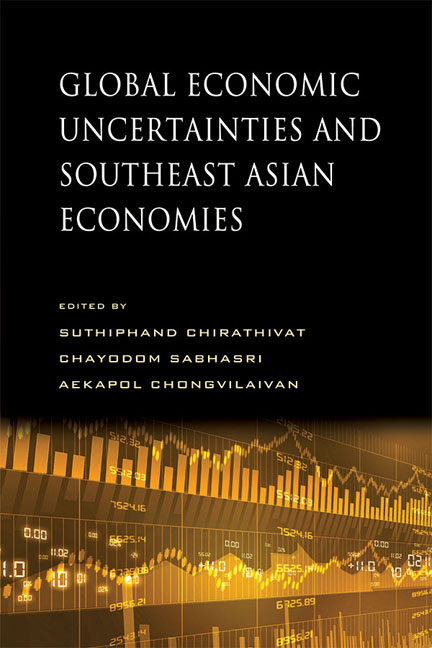Book contents
- Frontmatter
- Contents
- Preface
- Contributors
- 1 Challenges Facing a Globally Connected ASEAN
- 2 Fragile Balance of Payment in Indonesia under Global Economic Uncertainties
- 3 Malaysia in the Midst of Global Economic Uncertainties
- 4 Singapore: Reinventing Itself amid Global Economic Uncertainties
- 5 Thailand: Dependency or Diversification?
- 6 Vietnam's Economic Experience since WTO Accession
- 7 Global Economic Imbalances and Reform Policy: Evidence from Asian Economies
- 8 Foreign Exchange Rate Adjustment Policies in Asia
- 9 Monetary and Financial Architectures for ASEAN+
- 10 Global Uncertainties: Implications for the ASEAN Community
- Index
9 - Monetary and Financial Architectures for ASEAN+
Published online by Cambridge University Press: 22 July 2017
- Frontmatter
- Contents
- Preface
- Contributors
- 1 Challenges Facing a Globally Connected ASEAN
- 2 Fragile Balance of Payment in Indonesia under Global Economic Uncertainties
- 3 Malaysia in the Midst of Global Economic Uncertainties
- 4 Singapore: Reinventing Itself amid Global Economic Uncertainties
- 5 Thailand: Dependency or Diversification?
- 6 Vietnam's Economic Experience since WTO Accession
- 7 Global Economic Imbalances and Reform Policy: Evidence from Asian Economies
- 8 Foreign Exchange Rate Adjustment Policies in Asia
- 9 Monetary and Financial Architectures for ASEAN+
- 10 Global Uncertainties: Implications for the ASEAN Community
- Index
Summary
INTRODUCTION
The Asian Development Bank Institute (ADBI) drafted a report on ASEAN 2030, towards the borderless economic community. The objective of ASEAN 2030 is to become Resilient, Inclusive, Competitive, and Harmonious, or, a “RICH” ASEAN. To reach such a goal in 2030, we need to re-evaluate past ASEAN economic performance and policy implementations. ASEAN has gone through two recent economic and financial crises in 1997/8 and 2008/9. The ASEAN economies were hard hit by these crises. ASEAN has also moved in the direction of a borderless region — the process began in 1992; the next milestone will be in 2015, with the Economic Community. Given the significance of strengthening economic linkages, ASEAN+3 has been brought into the discussion. Several measures have been implemented to deal with the economic and financial crises, such as the establishment of the Chiang Mai Initiative Multilateralism, the Asian Bond Market, and the ASEAN Macroeconomic Research Office.
To achieve economic stability and growth, more areas of cooperation are needed, such as monetary policy, micro-prudential policy, and macro- and resolution. This chapter argues that some policy areas necessary for RICH to be realized are missing.
THE PAST ASEAN CRISES AND RESOLUTION
Since its inception in 1992, ASEAN has gradually become highly integrated with the international supply chain and international production networks. The foreign direct investment (FDI) and portfolio investment within ASEAN have increased significantly, not only from the region but also from the rest of the world due to the prosperity of the ASEAN economy.
The 1997/98 Asian Financial Crisis (AFC) alerted the countries of East Asia to the need for better management of their macroeconomic policies and financial systems. The AFC was caused by a combination of mismanagement by the authorities and financial liberalization. Poor monetary monitoring procedures, the defence of the fixed exchange rate system with limited international reserves, and the reversal of capital flows were among the causes of the AFC. Due to economic interdependence in the region through financial liberalization, all of the ASEAN economies were hard hit by the AFC. The monetary and macroeconomic policies were to be revised, and regional policy cooperation was designed to prevent any future crisis. As a result, a macroeconomic monitoring and surveillance system was formed at the ASEAN level.
- Type
- Chapter
- Information
- Global Economic Uncertainties and Southeast Asian Economies , pp. 218 - 241Publisher: ISEAS–Yusof Ishak InstitutePrint publication year: 2015



